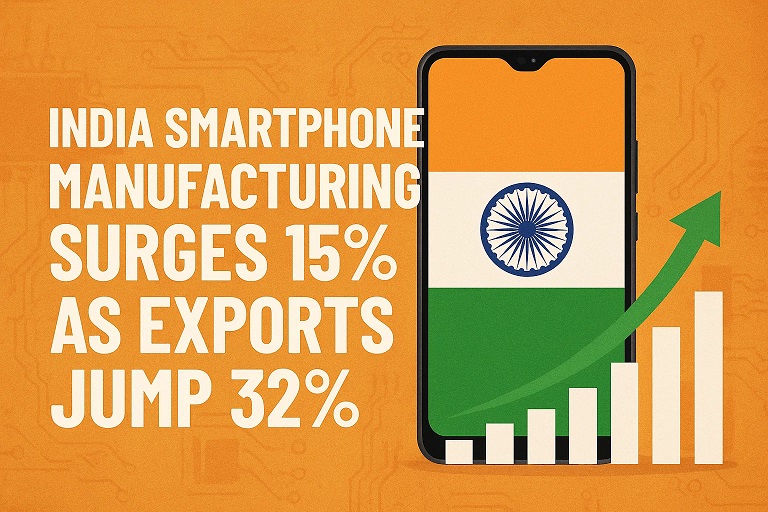India’s Smartphone Manufacturing Surge: 15% Growth with 32% Export Jump
Overview of the Manufacturing Boom
India’s smartphone manufacturing sector experienced a robust 15% year-on-year growth in the April-June 2025 quarter (Q1 FY26), driven by a 32% surge in exports, according to Counterpoint Research’s ‘Make in India Tracker’. This growth reflects the country’s rising prominence as a global manufacturing hub, with nearly 99% of smartphones sold domestically now produced locally. The surge is fueled by government initiatives like the Production Linked Incentive (PLI) scheme, increased production capacity, and a strategic shift by global brands like Apple to diversify supply chains, positioning India to meet both local and international demand.
Evolution of India’s Smartphone Industry
Historical Growth Trajectory
India’s smartphone manufacturing journey began with modest output in 2014-15, producing 60 million units valued at Rs 19,000 crore. The introduction of the PLI scheme in 2020 and the ‘Make in India’ initiative catalyzed a transformation, with production soaring to 330 million units valued at Rs 422,000 crore by 2023-24—a fivefold increase. Exports, once negligible, reached $15.6 billion in FY24, a 42% rise, and continued to climb with the latest 32% jump in Q1 FY26, reflecting a decade-long shift from an import-dependent market to a global exporter.
Strategic Industry Shift
The industry’s growth aligns with India’s goal to become a $300 billion electronics manufacturing hub by 2025-26. The PLI scheme, attracting giants like Apple and Samsung, has boosted production from two units in 2014-15 to over 300 by 2025. This shift is supported by a young workforce, cost-competitive labor, and government policies like reduced customs duties on components, enhancing India’s appeal as an alternative to China amid global supply chain diversification.
Manufacturing and Export Details
Production Growth
- Q1 FY26 Output: 15% year-on-year increase, with shipments reaching approximately 40 million units.
- Key Players: Dixon Technologies emerged as the top manufacturer with 196% growth, followed by Foxconn Hon Hai (71% growth) and Tata Electronics, driven by iPhone and Samsung production.
- Domestic Contribution: Nearly 99% of smartphones sold in India are locally made, supported by 300+ manufacturing units.
Export Surge
- Export Growth: 32% increase in Q1 FY26, with exports rising to an estimated $5-6 billion, led by the U.S. (54% of shipments).
- Top Destinations: The U.S. dominates, followed by the UAE, Netherlands, and UK, with Apple’s iPhone 16 leading export volumes at 18%.
- Drivers: U.S. tariffs on Chinese goods and Apple’s accelerated shift to India, producing a quarter of its iPhones there, have fueled this jump.
Growth Timeline and Projections
Period | Production Growth | Export Growth | Key Milestone |
|---|---|---|---|
| 2014-15 | Baseline (60M units) | Negligible | Start of ‘Make in India’ |
| 2023-24 | 5x increase (330M units) | 42% ($15.6B) | PLI scheme impact |
Q1 FY26 | 15% (40M units) | 32% ($5-6B) | U.S. market dominance |
| 2025-26 | Double-digit projected | 30-40% projected | $20B export target |
Benefits of the Surge
For India’s Economy
- Job Creation: The sector has generated 500,000 jobs, with projections for 150,000-200,000 more by FY25 end.
- Economic Growth: Contributes to a sixfold increase in electronics production, from Rs 1.9 lakh crore in 2014-15 to Rs 11.3 lakh crore in 2024-25.
- Self-Reliance: Reduces import dependence, with 97% of domestic demand met locally.
For Global Markets
- Supply Chain Resilience: Diversification from China strengthens global electronics supply chains.
- Export Revenue: The 32% export jump bolsters India’s foreign exchange reserves, targeting $20 billion in smartphone exports by 2025-26.
- Innovation Hub: Local manufacturing fosters R&D, with companies like Tata expanding into semiconductors.
Challenges and Risks
- Component Dependency: Heavy reliance on imported chips and displays increases costs and vulnerability to global shortages.
- Tariff Pressures: U.S. tariffs, potentially rising to 50%, could impact export growth unless exemptions continue.
- Infrastructure Gaps: Scaling production requires enhanced logistics and power supply reliability.
- Competition: China and Vietnam remain formidable rivals, with declining export shares (China -2.78%, Vietnam -17.6% in 2023-24).
Related Industry Developments
- PLI Scheme Expansion: Incentives have driven production from $30 billion in 2020 to $49 billion in 2023-24, with plans to extend benefits to components.
- Apple’s Role: Accounts for over 65% of exports, with Foxconn and Tata Electronics leading assembly.
- Semiconductor Push: India’s $10 billion semiconductor incentive scheme supports long-term manufacturing goals.
Comparison: India vs. Competitors
Country | Export Growth (2023-24) | Smartphone Share in U.S. (Q2 2025) | Key Advantage |
|---|---|---|---|
India | 32% (Q1 FY26) | 44% | PLI, labor cost |
China | -2.78% | 25% | Scale, tech |
Vietnam | -17.6% | 30% | Tax incentives |
Frequently Asked Questions (FAQs)
What drove the 15% manufacturing surge in India?
The PLI scheme, increased production capacity, and global brands like Apple shifting to India fueled the growth.
How significant is the 32% export jump?
It reflects a $5-6 billion increase in Q1 FY26, with the U.S. as the top market, targeting $20 billion by 2025-26.
Which companies lead India’s smartphone manufacturing?
Dixon Technologies, Foxconn Hon Hai, and Tata Electronics are key players, driven by iPhone and Samsung production.
What challenges face the industry?
Component imports, U.S. tariffs, infrastructure gaps, and competition from China and Vietnam pose risks.
How does this impact India’s economy?
It creates jobs, boosts GDP, and reduces import reliance, aligning with the $300 billion electronics goal by 2025-26.
What’s the role of the PLI scheme?
It has increased production fivefold since 2020 and supports exports, with plans to expand to components.












